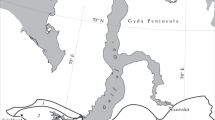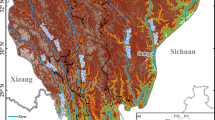Abstract
Large-scale wildfires and windstorms are the most important disturbance agents for the Russian boreal forests. The paper presents an assessment of fire-related and wind-induced forest losses in the Ural region of Russia for 2000‒2014. The assessment is based on the use of Landsat images, Global Forest Change dataset (Hansen et al. in Science 342:850–853, 2013. https://doi.org/10.1126/science.1244693) and other space imagery data. The total area of stand-replacement fires and windthrows in the Ural’s forests was estimated at 1.637 million ha, which is 1.56% of the total forest-covered area. The contribution of wildfires and windthrows is 96.4% and 3.6%, respectively. The highest frequency of large-scale wildfires was observed behind the Northern Ural ridge, where the fire scars of 2000‒2014 covered 10–14% of the forested area. The storm-related forest damage is significant only on the western part of the Ural. A few catastrophic wildfires and windthrows (with an area > 5000 ha) make up 35% of the entire damaged area. The number of wildfires, windthrows and their damaged area vary significantly from year to year. For 2000–2014, it is impossible to find a statistically significant trend of the fire- and storm-damaged area. The seasonal maximum of large-scale wildfires and windthrows was observed in July. Also, we identified the statistically significant relationships of fire- and wind-related forest damage with environmental variables. The occurrence of large-scale wildfires is related mainly to the species composition of forests, and also to the altitude, the mean annual precipitation and the population density. The spatial distribution of massive windthrows has a strong correlation with the species composition of forests, the mean annual precipitation and partially with the wind effect parameter.











Similar content being viewed by others
References
Afonin AN, Grin SL, Dzubenko NI, Frolov AN (eds) (2008) The agroecological atlas of Russia and neighbouring countries: economically significant plants, their pests, diseases and weeds (web-version 2.0). Document freely available on the internet at: http://www.agroatlas.ru
Baranovskiy N, Krechetova S, Belikova M, Perelygin A (2016) WWLLN data cluster analysis methods for lightning-caused forest fires monitoring. Int J Electr Comput Eng 6(6):3112–3120. https://doi.org/10.11591/ijece.v6i6.12780
Bartalev SA, Ershov DV, Isaev AS, Potapov PV, Turubanova SA, Yaroshenko AYu (2004) Russia’s forests—dominating forest types and their canopy density. Greenpeace Russia and RAS Centre for Forest Ecology and Productivity, Moscow (Map, scale 1:14 000 000)
Bartalev SA, Egorov VA, Loupian EA, Uvarov IA (2007) Multi-year circumpolar assessment of the area burnt on boreal ecosystems using SPOT-VEGETATION. Int J Remote Sens 28(6):1397–1404. https://doi.org/10.1080/01431160600840978
Baumann M, Ozdogan M, Wolter PT, Krylov A, Vladimirova N, Radeloff VC (2014) Landsat remote sensing of forest windfall disturbance. Remote Sens Environ 143:171–179. https://doi.org/10.1016/j.rse.2013.12.020
Bech J, Gayà M, Aran M, Figuerola F, Amaro J, Arús J (2009) Tornado damage analysis of a forest area using site survey observations, radar data and a simple analytical vortex model. Atmos Res 93(1–3):118–130. https://doi.org/10.1016/j.atmosres.2008.10.016
Chuvieco E, Aguado I, Yebra M, Nieto H, Salas J, Martín MP, Vilar L, Martínez J, Martín S, Ibarra P, de la Riva J, Baeza J, Rodríguez F, Molina JR, Herrera MA, Zamora R (2010) Development of a framework for fire risk assessment using remote sensing and geographic information system technologies. Ecol Model 221(1):46–58. https://doi.org/10.1016/j.ecolmodel.2008.11.017
Cohen WB, Spies TA, Alig RJ, Oetter DR, Maiersperger TK, Fiorella M (2002) Characterizing 23 years (1972‒95) of stand replacement disturbance in western Oregon forests with Landsat imagery. Ecosystems 5(2):122–137. https://doi.org/10.1007/s10021-001-0060-X
De Groot WJ, Cantin AS, Flannigan MD, Soja AJ, Gowman LM, Newbery A (2013) A comparison of Canadian and Russian boreal forest fire regimes. For Ecol Manag 294:23–34. https://doi.org/10.1016/j.foreco.2012.07.033
Degteva SV, Ponomarev VI, Eisenman SW, Dushenkov V (2015) Striking the balance: challenges and perspectives for the protected areas network in northeastern European Russia. Ambio 44(6):473–490. https://doi.org/10.1007/s13280-015-0636-x
Díaz-Delgado R, Lloret F, Pons X (2004) Spatial patterns of fire occurrence in Catalonia, NE, Spain. Landsc Ecol 19(7):731–745. https://doi.org/10.1007/s10980-005-0183-1
Diffenbaugh NS, Scherer M, Trapp RJ (2013) Robust increases in severe thunderstorm environments in response to greenhouse forcing. Proc Natl Acad Sci USA 110(41):16361–16366. https://doi.org/10.1073/pnas.1307758110
Dmitrieva TG, Peskov BE (2016) Synoptic conditions, nowcasting, and numerical prediction of severe squalls and tornados in Bashkortostan on June 1, 2007 and August 29, 2014. Russ Meteorol Hydrol 41(10):673–682. https://doi.org/10.3103/S1068373916100022
Dyer RC (1988) Remote sensing identification of tornado tracks in Argentina, Brazil, and Paraguay. Photogramm Eng Remote Sens 54:1429–1435
Egorov VA, Bartalev SA, Loupian EA, Stytsenko FV (2008) A comparative analysis of the results of the detection of burned areas on the territory of Northern Eurasia according to SPOT-Vegetation and Terra-MODIS data. Curr Probl Remote Sens Earth Space 5(2):292–296 (in Russian)
Eliseev AV, Mokhov II, Chernokulsky AV (2014) Influence of ground and peat fires on CO2 emissions into the atmosphere. Dokl Earth Sci 459(2):1565–1569. https://doi.org/10.1134/S1028334X14120034
Fick SE, Hijmans RJ (2017) WorldClim 2: new 1-km spatial resolution climate surfaces for global land areas. Int J Climatol 37(12):4302–4315. https://doi.org/10.1002/joc.5086
Gardiner B, Byrne K, Hale S, Kamimura K, Mitchell SJ, Peltola H, Ruel J-C (2008) A review of mechanistic modelling of wind damage risk to forests. Forestry 81(3):447–463. https://doi.org/10.1093/forestry/cpn022
Giglio L, Schroeder W, Justice CO (2016) The collection 6 MODIS active fire detection algorithm and fire products. Remote Sens Environ 178:31–41. https://doi.org/10.1016/j.rse.2016.02.054
Gregow H, Laaksonen A, Alpe ME (2017) Increasing large scale windstorm damage in Western, Central and Northern European forests, 1951‒2010. Sci Rep 7, Article 46397. https://doi.org/10.1038/srep46397
Groenemeijer P, Kuhne T (2014) A climatology of tornadoes in Europe: results from the European Severe Weather Database. Mon Weather Rev 142:4775–4790. https://doi.org/10.1175/MWR-D-14-00107.1
Groisman PYa, Sherstyukov BG, Razuvaev VN, Knight RW, Enloe JG, Stroumentova NS, Whitfield PH, Førland E, Hannsen-Bauer I, Tuomenvirta H, Aleksandersson H, Mescherskaya AV, Karl TR (2007) Potential forest fire danger over Northern Eurasia: changes during the 20th century. Global Planet Change 56(3–4):371–386. https://doi.org/10.1016/j.gloplacha.2006.07.029
Hansen MC, Potapov PV, Moore R, Hancher M, Turubanova SA, Tyukavina A, Thau D, Stehman SV, Goetz SJ, Loveland TR, Kommareddy A, Egorov A, Chini L, Justice CO, Townshend JRG (2013) High-resolution global maps of 21st-century forest cover change. Science 342:850–853. https://doi.org/10.1126/science.1244693
Jedlovec GJ, Nair U, Haines SL (2006) Detection of storm damage tracks with EOS data. Weather Forecast 21:249–267. https://doi.org/10.1175/WAF923.1
Koroleva NV, Ershov DV (2012) Estimation of error in determining the forest windfall disturbances area on high spatial resolution space images of LANDSAT-TM. Curr Probl Remote Sens Earth Space 9:80–86 (in Russian)
Krylov AM, Malahova EG, Vladimirova NA (2012) Identification and assessment of forest areas damaged by windfalls in 2009–2010 by means of remote sensing. Bull Saint-Petersburg Acad Forest Manag 200:197–207 (in Russian)
Krylov A, Potapov P, Loboda T, Tyukavina A, Turubanova S, Hansen MC, McCarty JL (2014) Remote sensing estimates of stand-replacement fires in Russia, 2002–2011. Environ Res Lett 9(10), Article 105007. https://doi.org/10.1088/1748-9326/9/10/105007
Kukavskaya EA, Buryak LV, Shvetsov EG, Conard SG, Kalenskaya OP (2016) The impact of increasing fire frequency on forest transformations in southern Siberia. For Ecol Manag 382:225–235. https://doi.org/10.1016/j.foreco.2016.10.015
Lassig R, Moĉalov SA (2000) Frequency and characteristics of severe storms in the Urals and their influence on the development, structure and management of the boreal forests. For Ecol Manag 135:179–194. https://doi.org/10.1016/S0378-1127(00)00309-1
Loboda T, O’Neal KJ, Csiszar I (2007) Regionally adaptable dNBR-based algorithm for burned area mapping from MODIS data. Remote Sens Environ 109:429–442. https://doi.org/10.1016/j.rse.2007.01.017
Moĉalov SA (2002) Global climate changes and the problems of forest ecology. Bull Ural State Univ 23:48–53 (in Russian)
National Atlas of Russia (2008) Borodko AV (ed) Population and economy, vol 3, p 495. Document freely available on the internet at: http://national-atlas.ru/ (in Russian)
Nilsson C, Stjernquist I, Bärring L, Schlyter P, Jönsson AM, Samuelsson H (2004) Recorded storm damage in Swedish forests 1901-2000. For Ecol Manag 199(1):165–173. https://doi.org/10.1016/j.foreco.2004.07.031
Panferov O, Doering C, Rauch E, Sogachev A, Ahrends B (2009) Feedbacks of windthrow for Norway spruce and Scots pine stands under changing climate. Environmental Research Letters 4(4):Art. no. 045019. https://doi.org/10.1088/1748-9326/4/4/045019
Potapov P, Turubanova S, Zhuravleva I, Hansen M, Yaroshenko A, Manisha A (2012) Forest cover change within the Russian European North after the Breakdown of Soviet Union (1990–2005). Int J For Res 2012, Article 729614. https://doi.org/10.1155/2012/729614
Potapov PV, Turubanova SA, Tyukavina A, Krylov AM, McCarty JL, Radeloff VC, Hansen MC (2015) Eastern Europe’s forest cover dynamics from 1985 to 2012 quantified from the full Landsat archive. Remote Sens Environ 159:28–43. https://doi.org/10.1016/j.rse.2014.11.027
Schelhaas MJ, Nabuurs GJ, Schuck A (2003) Natural disturbances in the European forests in the 19th and 20th centuries. Glob Change Biol 9(11):1620–1633. https://doi.org/10.1046/j.1365-2486.2003.00684.x
Schlyter P, Stjernquist I, Bärring L, Jönsson AM, Nilsson C (2006) Assessment of the impacts of climate change and weather extremes on boreal forests in northern Europe, focusing on Norway spruce. Clim Res 31:75–84. https://doi.org/10.3354/cr031075
Seidl R, Fernandes PM, Fonseca TF, Gillet F, Jönsson AM, Merganičová K, Netherer S, Arpaci A, Bontemps J-D, Bugmann H, González-Olabarria JR, Lasch P, Meredieu C, Moreira F, Schelhaas M-J, Mohren F (2011a) Modelling natural disturbances in forest ecosystems: a review. Ecol Model 222(4):903–924. https://doi.org/10.1016/j.ecolmodel.2010.09.040
Seidl R, Schelhaas MJ, Lexer MJ (2011b) Unraveling the drivers of intensifying forest disturbance regimes in Europe. Glob Change Biol 17(9):2842–2852. https://doi.org/10.1111/j.1365-2486.2011.02452.x
Seidl R, Schelhaas M-J, Rammer W, Verkerk PJ (2014) Increasing forest disturbances in Europe and their impact on carbon storage. Nat Clim Change 4:806–810. https://doi.org/10.1038/nclimate2318
Seidl R, Thom D, Kautz M, Martin-Benito D, Peltoniemi M, Vacchiano G, Wild J, Ascoli D, Petr M, Honkaniemi J, Lexer MJ, Trotsiuk V, Mairota P, Svoboda M, Fabrika M, Nagel TA, Reyer CPO (2017) Forest disturbances under climate change. Nat Clim Change 7(6):395–402. https://doi.org/10.1038/nclimate3303
Shikhov AN, Chernokulsky AV (2018) A satellite-derived climatology of unreported tornadoes in forested regions of northeast Europe. Remote Sens Environ 204:553–567. https://doi.org/10.1016/j.rse.2017.10.002
Shuman JK, Foster AC, Shugart HH, Hoffman-Hall A, Krylov A, Loboda T, Ershov D, Sochilova E (2017) Fire disturbance and climate change: implications for Russian forests. Environ Res Lett 12(3), Article 035003. https://doi.org/10.1088/1748-9326/aa5eed
Soja AJ, Tchebakova NM, French NHF, Flannigan MD, Shugart HH, Stocks BJ, Sukhinin AI, Parfenova EI, Chapin FS III, Jr S (2007) Climate-induced boreal forest change: predictions versus current observations. Global Planet Change 56(3–4):274–296. https://doi.org/10.1016/j.gloplacha.2006.07.028
Stytsenko FV, Bartalev SA, Egorov VA, Loupian EA (2013) Post-fire forest tree mortality assessment method using MODIS satellite data. Curr Probl Remote Sens Earth Space 10:254–266 (in Russian)
Virts KS, Wallace JM, Hutchins ML, Holzworth RH (2013) Highlights of a new ground-based, hourly global lightning climatology. Bull Am Meteorol Soc 94(9):1381–1391. https://doi.org/10.1175/BAMS-D-12-00082.1
Vorobiev YuL, Akimov VA, Sokolov YUI (2004) Forest fires in Russia: current state and problems. The Ministry of Emergency of Russia, Moscow (in Russian)
Wulder MA, Masek JG, Cohen WB, Loveland TR, Woodcock CE (2012) Opening the archive: how free data has enabled the science and monitoring promise of Landsat. Remote Sens Environ 122:2–10. https://doi.org/10.1016/j.rse.2012.01.010
Acknowledgements
The study was funded by the Russian Foundation for Basic Research (Projects No. 16-05-00245-a) and the RF President Grant MK-801.2017.5.
Author information
Authors and Affiliations
Corresponding author
Additional information
Publisher's Note
Springer Nature remains neutral with regard to jurisdictional claims in published maps and institutional affiliations.
Electronic supplementary material
Below is the link to the electronic supplementary material.
Rights and permissions
About this article
Cite this article
Shikhov, A.N., Perminova, E.S. & Perminov, S.I. Satellite-based analysis of the spatial patterns of fire- and storm-related forest disturbances in the Ural region, Russia. Nat Hazards 97, 283–308 (2019). https://doi.org/10.1007/s11069-019-03642-z
Received:
Accepted:
Published:
Issue Date:
DOI: https://doi.org/10.1007/s11069-019-03642-z




